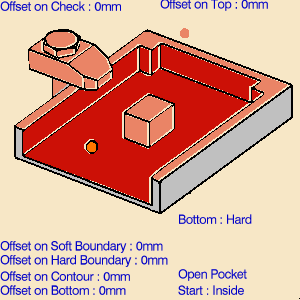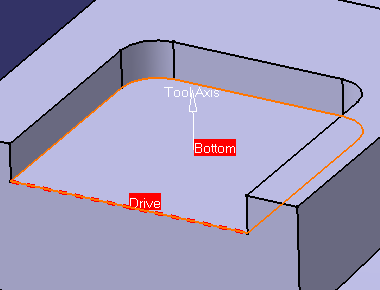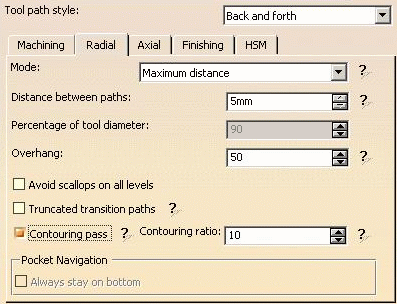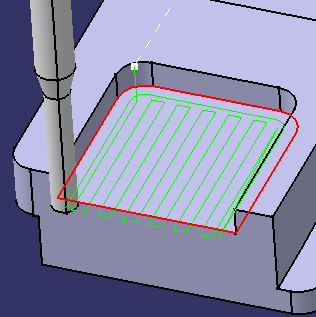|
|
This task shows how to insert a
Pocketing operation in the program when the
pocket to be machined comprises at least one soft boundary (that is, an
open pocket). To create the operation you must define:
|
|
|
|
Open the
PrismaticMilling02.CATPart document, then select Machining >
Prismatic Machining from the Start menu. Make the Manufacturing
Program current in the specification tree. |
|
|
|
1. | Select Pocketing
A Pocketing entity along with a default tool is added to the program.
The Pocketing dialog box appears directly at the
Geometry tab page
|
|
|
The bottom and flanks of the icon are colored red indicating that this geometry is required for defining the pocket. All other pocket geometry is optional. | |
| Make sure that the Pocketing style is set to Open Pocket. | ||
| 2. | Right click the red Bottom in the icon and
select Contour Detection from the contextual menu.
Click the red Bottom then select the desired pocket bottom in the 3D window. |
|
| The pocket boundary is automatically deduced
thanks to the Contour Detection setting. This is indicated by the
highlighted Drive elements. Hard boundaries are shown by full lines and soft boundaries by dashed lines.
For edge selection only, you can change a boundary segment from hard to soft (or from soft to hard) by selecting the corresponding edge. You can also globally change segments from hard to soft and from soft to hard using the Swap Hardness Mode contextual command. |
||
|
|
The bottom and flanks of the icon are now colored green indicating
that this geometry is now defined.
For parts containing islands, you can right click the red Bottom in the icon and select Island Detection from the contextual menu. This allows island boundaries to be deduced automatically. |
|
| 3. | Click the Top Plane in the icon then select the desired top element in the 3D window. | |
| 4. | Set the following offsets:
|
|
|
|
If your part includes islands, you can specify different offsets on individual islands using the Offset on Island contextual command (right click the Island label in the 3D window). | |
| 5. | Select the Strategy tab
page |
|
|
You can then use the tab pages to set parameters for:
For Back and forth, you can modify the proposed machining direction and progression direction that are symbolized by arrows next to the machining axis system. Clicking the Machining direction arrow displays a dialog box for specifying the direction of paths. Clicking the Progression direction arrow reverses the overall direction of progression of the paths. |
||
| 6. | A tool is proposed by default when you want to create a
machining operation. If the proposed tool is not suitable, just select
the Tool tab page
This is described in Edit the Tool of an Operation. |
|
| 7. | Select the Feeds and Speeds tab
page |
|
| 8. | Select the Macros tab
page
|
|
| See Define Macros of an Operation for another example of specifying transition paths on a machining operation. | ||
| 9. | Before accepting the operation, you should check its
validity by
replaying the tool path.
|
|
| 10. | Click OK to create the operation. | |
|
|
||




